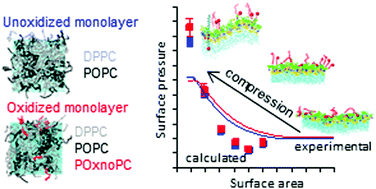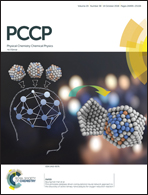The impact of lipid oxidation on the functioning of a lung surfactant model†
Abstract
Apart from being responsible for sufficient pulmonary compliance and preventing alveolar collapse, lung surfactant (LS) also forms the first barrier for uptake of inhaled pathogens. As such it is susceptible to damage caused by various deleterious compounds present in air, e.g. oxidants capable of oxidizing unsaturated LS lipids. This study examines the consequences of oxidizing 20% of unsaturated lipids in an LS model: a mixed 1 : 1 DPPC : POPC monolayer. POxnoPC (1-palmitoyl-2-(9-oxo-nonanoyl)-sn-glycero-3-phosphocholine) is considered as the main oxidation product. Experimental surface pressure–area isotherms and polarization–modulation infrared reflection–absorption spectroscopy are employed to probe changes in the macroscopic properties of the unsaturated lipid monolayer induced by oxidation. Microscopic details of the influence of oxidation on the monolayer's phase behavior are elucidated by molecular dynamics simulations at varying lipid packing. We demonstrate that unsaturated lipid oxidation shifts the isotherm towards larger areas and advances monolayer collapse. This is caused by a reversal of the oxidized sn-2 chains of POxnoPC towards the subphase, driven by electrostatic interactions between the aldehyde, glycerin, and water. Increased lipid bulkiness, hindered transition to the LC phase, and transfer of oxidized chain terminals to the subphase have been identified as the most troublesome consequences of this process. They result in the reduction of monolayer stability and its capability to withstand high surface pressures. This may lead to uncontrolled and irreversible loss of lipids from the surface.



 Please wait while we load your content...
Please wait while we load your content...